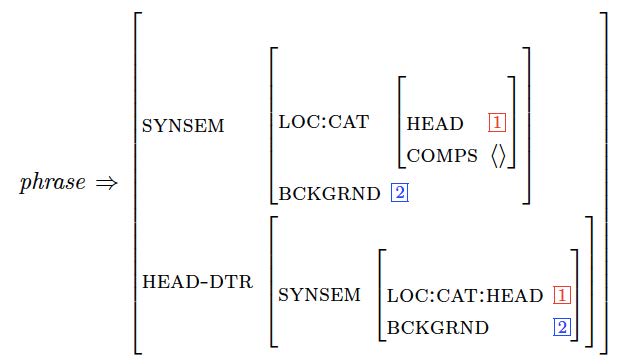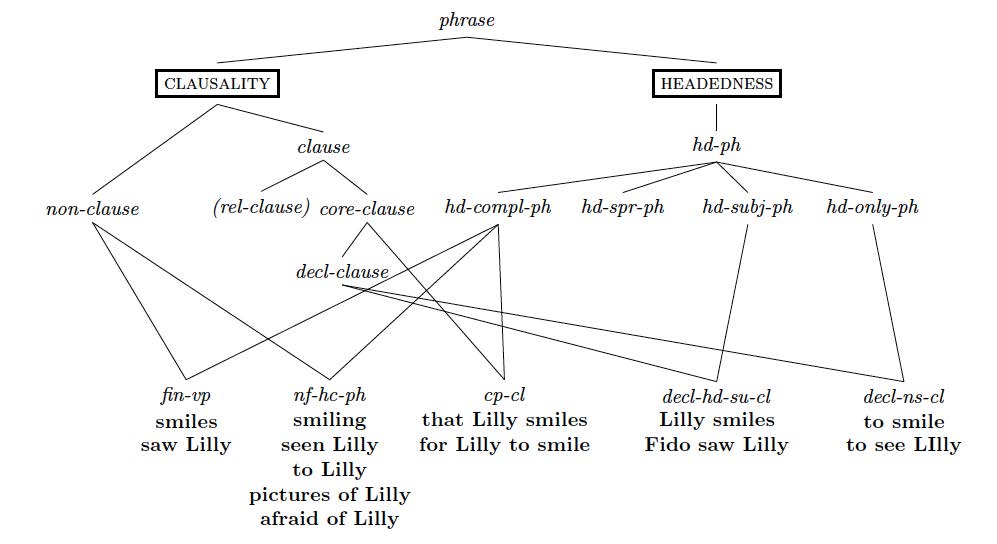Constraint-based Syntax 2: Week 3
Maximal phrase types
In Week 1, the following 3 phrase types were introduced: hd-subj-ph, hd-spr-ph, and hd-comp-ph.
Head-Specifier Phrases
Exercise: parse the 3 expressions cat, a, and a cat in order to see how the valence features of the noun drive the formation of the hd-spr-ph the cat.
Online Grammar for Chapter 2: HPSG Background
For the moment, there is little more to say about head-specifier phrases.
Clauses and non-clauses
Following traditional grammar, GS make use of the concept of clauses, i.e. declarative clauses, interrogative clauses, etc. All clauses are phrases, but there are of course non-clausal phrases as well, for instance, VPs, NPs, APs, and PPs. In order to license these non-clausal phrases, GS postulate the following subtypes of hd-comp-ph, to which we have added the subtype sbjn-vp to license subjunctive VPs. The crucial difference between the phrases is the choice of the head, as shown in the table:
| Subtype of hd-comp-ph | Full name | Distinctive property | Example |
|---|---|---|---|
| fin-vp | Finite verb phrase | the head is V[fin] | snores, likes Fido |
| sbjn-vp | Subjunctive verb phrase | the head is V[sbjn] | be happy, dance, give Lilly a book |
| nf-hc-ph | Non-finite head-complement phrase | the head is a non-finite V or N, A, P | dancing, depended on Fido, afraid of Fido, picture of Lilly |
| cp-ph | Complementizer phrase | the head is C | that Lilly danced, for Lilly to like Fido |
- Note
- The four subtypes of hd-comp-ph listed above are all the subtypes of hd-comp-ph that exist in this grammar and they are mutually incompatible. This means that every hd-comp-ph must also be one and only one of its maximal subtypes! As a consequence, in the online grammar you will never see the type hd-comp-ph; instead, when a head combines with its complements, the program will display one of the maximal four subtypes listed in the table.
Exercise: parse all of the examples above and examine the structure of the respective phrases and how they are licensed by the information in the head daughter (HEAD, VFORM, and COMPS).
Online Grammar for Chapter 2: HPSG Background
Clauses
Clauses play a central role in GS' theory of English grammar. First, they have their own syntactic and semantic characteristics, which distinguish them from non-clauses. Secondly, they recognize a number of different clauses types that each have a distinctive combination of syntactic and semantic properties.
States of Affairs vs. Messages
In the system of GS, verbs and verb phrases have states of affairs (soa) as their content. Simplifying somewhat for now, a state of affairs consists of a situation in which objects that are present in the situation (which may be people, things, properties, etc.) stand in a certain relationship to each other. Here are some informal examples:
- a state of affairs involving two entities, Fido and Lilly, who stand in the relationship that he chases her (in this state of affairs)
- a state of affairs involving three entities, a book, Fido, and Lilly, who stand in the relationship that her gave it to her
- a state of affairs involving one entity, Lilly, who stands in the relationship that she snores (it is kind of awkward to say that something stands in a one-place relationship - it would be more intuitive in this case to say that Lilly has the property of snoring. But to keep the system general, we will also use the word relation when there is only a single object involved in the state of affairs.)
Note that a state of affairs is completely abstract: all by itself, nothing is said about whether there is such a state of affairs or not and nothing is said about whether somebody believes, claims, denies, or dreams of such a state of affairs! This is precisely the crucial difference between non-clauses and clauses: non-clauses such as verbs and verb phrases have such abstract states of affairs as their content. In contrast, clauses express messages about a state of affairs. One type of message is proposition, the claim that a state of affairs actually holds. Thus, the sentence Lilly chases Fido expresses the proposition that there is a state of affairs where she chases him and by uttering this sentence, a speaker actually commits herself to the truth of the proposition, i.e. to the claim that the world corresponds to the state of affairs described in the sentence she uttered. In our case, this means that by uttering the sentence Lilly chases Fido, the speaker claims that it is true that she chases him.
Each message type is grammatically associated with a distinct clause type (= a conventional combination of syntax and semantics) by the grammar of English. Since there are four message types, there also are four clause types. The table below illustrates the one-to-one relationship between message and clause types:
| Clause type | Full name | Message type | Examples |
|---|---|---|---|
| decl-clause | declarative clause | proposition | Lilly danced. |
| inter-clause | interrogative clause | question | Does Lilly dance?, Who danced? |
| imp-clause | imperative clause | outcome | Dance! |
| excl-clause | exclamative clause | fact | What a cat!, Is Lilly smart! |
The first case has already been discussed. The remaining cases are analogous. An interrogative clause expresses the message question. By uttering such a clause, the speaker can ask whether the state of affairs which is part of the message holds or doesn't hold. An imperative clause expresses the outcome that the speaker wishes the addressee to bring about i.e. which state of affairs should come to hold as a result of the speaker uttering this type of clause to one or more hearers. Finally, an exclamative clause expresses a fact which the speaker considers surprising or unusual.
In the following sections, we will present a number of constraints on non-clausal and clausal phrases that interact to define the four types of head-complement phrases and the four types of clauses introduced in this section.
Constraints on all Phrases
There are 3 simple principles that apply to all phrases, clausal and non-clausal alike.
Empty COMPS Constraint (ECC)
Informally: phrases have empty COMPS values.
Head Feature Principle
Informally: phrases and their head daughters have identical HEAD features.
Background Inheritance Principle
Informally: phrases and their head daughters have identical values for the feature BCKGRND.
The 3 Phrase Principles Combined
The Phrase Hierarchy
Navigation:














